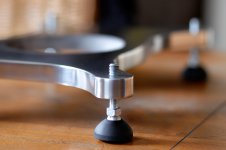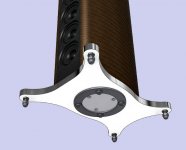The author of the article linked this video down in the comment section.
The Mystery Behind Carnegie Hall's Curtains | Sound Mysteries - YouTube
The Mystery Behind Carnegie Hall's Curtains | Sound Mysteries - YouTube
I also have the experience that rubber feet or somthing similar help a lot to have a clearer bass than spikes. So i quit using them. Even cheap ordinary rubber feet like i use a lot help a lot. They did it in my old house (parket (wood) floor on wooden beams) and in my new house (granite coglomerate tiles on clay-brick/cement underfloor as i live in a centuries old farm now).
Same experience here... I used a sort of "poor man's spikes" at first (threaded rods with a small contact patch each to the floor) and wasn't sure about the results on my wood floor.
So I moved on to using these industrial type damping feet:

Much better using that in combination with the wood floor I have in my house which was build back in 1925. Brick house with suspended wood floor.
It might have been a different experience if I had concrete floors.
Here's the idea behind the poor man's spikes I was using:

So I moved on to using these industrial type damping feet:
Much better using that in combination with the wood floor I have in my house which was build back in 1925. Brick house with suspended wood floor.
It might have been a different experience if I had concrete floors.
Here's the idea behind the poor man's spikes I was using:
Attachments
Last edited:
Me 2c....
I've always thought spikes were nuts...guaranteed amplifiers of cabinet to floor vibration transmissions.
Best practices I've found are:
Vibrational force cancellation (for subs), using opposed drivers in a push-push or push-pull setups.
Separate enclosures for driver sections, with vibration dampening material between cabinents (such as neoprene, sorbothane, or even a dang rug, etc)
After those simple practices, it gets kinda ironic imo...
in that airborn vibration from truly good bass will still excite everything around...and in a good way...much like the Carnegie Hall vid and the stage floor sound...
One of the great joys my feet "hear", is the trussed floor in my room vibrating perfectly in time from solely air born vibration.
It's like in a car, when you feel through armrests, or seats, or wheel, etc... the music coming though...it feels right and good.
And it's strong ! Alot stronger than the twiddle dink vibration stuff often worried about.
So I think get rid of any obvious cabinet rattles and resonances, but do nothing more and embrace how the speakers couple air born with the structure around them.
I've always thought spikes were nuts...guaranteed amplifiers of cabinet to floor vibration transmissions.
Best practices I've found are:
Vibrational force cancellation (for subs), using opposed drivers in a push-push or push-pull setups.
Separate enclosures for driver sections, with vibration dampening material between cabinents (such as neoprene, sorbothane, or even a dang rug, etc)
After those simple practices, it gets kinda ironic imo...
in that airborn vibration from truly good bass will still excite everything around...and in a good way...much like the Carnegie Hall vid and the stage floor sound...
One of the great joys my feet "hear", is the trussed floor in my room vibrating perfectly in time from solely air born vibration.
It's like in a car, when you feel through armrests, or seats, or wheel, etc... the music coming though...it feels right and good.
And it's strong ! Alot stronger than the twiddle dink vibration stuff often worried about.
So I think get rid of any obvious cabinet rattles and resonances, but do nothing more and embrace how the speakers couple air born with the structure around them.
I found this video interesting about Carnegie Hall's renovation.
The Mystery Behind Carnegie Hall's Curtains | Sound Mysteries - YouTube
The Mystery Behind Carnegie Hall's Curtains | Sound Mysteries - YouTube
- Home
- Loudspeakers
- Multi-Way
- Bob Katz study on loudspeaker isolation..

